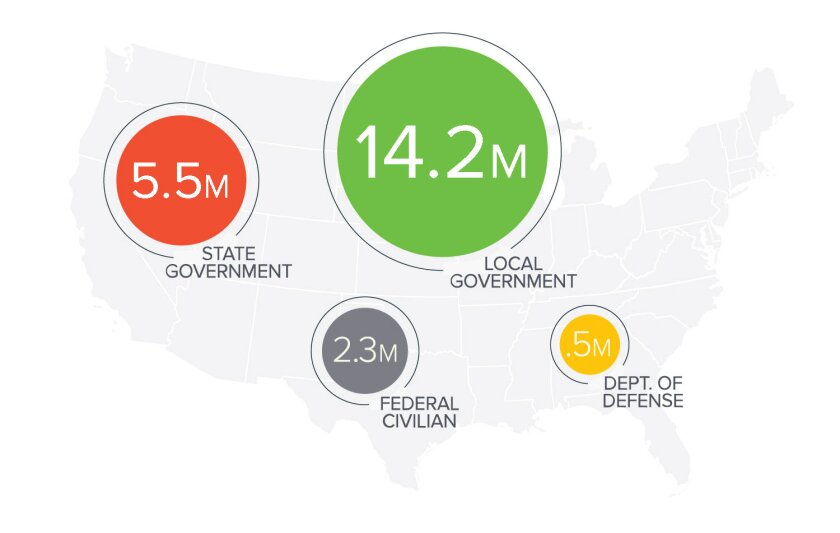There is a need for efficient communication in local governments and public sectors with staff, the public and other organisations. Here’s how to attain this:
Local government is an essential part of our society, and in the US alone, it employs nearly 19 million people, with 4.6 million working in state government and more than 14 million working in local government. In fact, it’s fair to compare local government to most major private sector organisations.
As such, there’s as much need for efficient communication as there is in any large business. Local government communication is essential for every local government entity. It needs not only to communicate internally with its staff but also with the public it serves as well as with other organisations, contractors, subcontractors, and other government agencies at local, state, and federal levels.
That means that with the same needs as private sector organisations, the public sector is often looking at the same sort of solutions. In the modern era, many local government organisations will operate call centres and have other communication demands that any large business would have.

How do such entities embrace the digital era of communications to provide a better service?
What is the need for local government communication?
In many ways, local government is no different to a commercial business. While a commercial organisation may look at how to make money with affiliate marketing, the public sector receives remuneration in a different way.
Although business owners may hire an affiliate marketer to boost their brand’s communication with the public, governments have other ways of communicating with the public. Governments must keep their overall budgets in mind when it comes to communicating internally and externally as they must try and balance their books in any fiscal year. So, where does local government revenue come from?
While percentages may vary between states, the two main sources of revenue come from funding from state and federal governments and the collection of property taxes. From the funds collected, local government has to provide a wide range of services, including education, policing and welfare.
That requires a very high level of communication within departments, between departments, and with the public they serve. That communication can take the form of everything from newsletters to call centres that utilise call forwarding software.
What’s certain is that local government needs efficient and modern channels of communication to maintain that high level of contact, for example, using PBX cloud services.
The need for internal communications
Putting the public aside, momentarily, there’s a need for efficient local government communication as a whole, within departments, and between departments. Looking at the most populous state, California, there are around 2.5 million people working at all levels of government, representing some 15.4% of the total workforce.
Having a solid internal communication strategy is as important within local government as it is within an eCommerce giant. What key goals should such a strategy be aiming for?
- Ensuring your employees recognise and understand the priorities of their roles.
- Sharing policies, both those of your local government as a whole and of individual departments.
- Increasing engagement with your employees and giving them channels to provide feedback.
- Encouraging collaboration and cooperation as well as letting employees share ideas on how to improve services.
- Minimising exposure to risk through health and safety policies and good practices.
- Ensuring employees work efficiently while following any relevant policies.
By having a clear strategy and a good communication framework that supports that strategy, you can help ensure that your employees are more engaged with their work and your organisation. That can mean better job satisfaction as well as a more productive and efficient workforce.
If you fail to ensure your workforce is engaged, productivity and efficiency levels will drop, and there’ll be higher levels of human error and staff turnover. Just as with a private sector organisation, the costs of hiring, onboarding, and training new staff can have a severe impact on your budget.
Whereas the organisational culture of a commercial business may remain static and focused, there can be times when the culture in local government is dictated by political leadership, so it may vary greatly between states.
However, there will still be many common traits, and that culture should be communicated to staff so they understand your key messages and the direction you want to take.
While your primary role may be to provide services to the public in your area, having both a solid internal communications strategy and the means to deliver it is the foundation of everything you do. That means embracing the various new technologies on the market, like video conferencing software and omnichannel platforms.

Challenges of internal communications
Nobody said things would be easy, especially when you consider the differences between public and private sector organisations. Local government tends to have a more complex structure that has a set hierarchy and is very much defined by its bureaucracy, whereas a private sector entity has a more linear and clearly defined management structure.
Here are the most common challenges and suggested solutions:
-
Structure
You have multiple departments that often seem to operate in a vacuum and will have different operational strategies as well as often having different policies and jargon. Different departments can be spread over large geographical areas and, in some cases, different time zones.
Solution:
Build a plan that sets out all your internal communication goals and how you plan to achieve them. That plan can include any programs or hardware that will be used as well as clearly defined protocols and committing to use plain, non-jargon language. Also, be aware of any state-specific policies regarding the use of more than one language and include that in any plan.
2. Too outward-looking
Because you’re a public sector organisation, one fault you may find with your communications is that they tend to be public-centric. You want your service users to know all necessary details, but that focus can often come at a cost with more resources dedicated to that side than to your internal communications.
Solution:
For every project you undertake in each department, focus on internal communications. Look at what each department needs in terms of resources and build templates for every department to follow, at least at a basic level. Highlight key needs and messages and investigate whether you can have the same channels across your organisation.
3. Coping with change
Change can be challenging. Within the public sector, change may happen more often than in the private sector, including in terms of the needs of service users and in terms of political direction.
There can also be major changes in one department and none in others. So this presents another hurdle. Changing policies that aren’t communicated well can lead to errors and confusion.
Solution:
To counter challenges caused by any changes in policy, you need an effective strategy for management communication. This can make it easier for other staff to learn of any changes, understand any impacts of those changes, and also see what relevance the changes have on staff members and service users. You can also consider creating engaging webinars to help disseminate information.
4. Budget issues
A major issue faced by public sector organisations across the world has always been budget restraints. Budget issues can also affect internal communications as there may not be the funds to do things the way you want to.
Look at ways of consolidating your internal communications platforms and channels. For example, it could save money if all departments were using the same communications platform rather than a range of different ones.
5. Too much information
There’s a huge amount of information within public sector entities that’s communicated on a daily basis. This could mean that some essential information could easily be lost among that white noise. With so much information, in the shape of emails, instant messages, calls to your small business phone systems, and so on, it can quickly get confusing and distract from other tasks.
Solution:
When information comes from the “top,” you need to check if it needs to be sent to all staff or is department specific. Think about information silos where necessary, and when information needs to be sent to all employees, consider highlighting it through the use of tools like popup alerts.
External communications
It may sound strange for an organisation that serves the public, but having a solid internal communication strategy, including implementing the required tools and platforms, provides a solid foundation for developing your external communications. Many of the problems you face internally are the same or similar to those you’ll face when communicating with service users.
The most important thing to recognize is that the public want to be able to contact you—and vice versa—on a wide range of channels and platforms, so you need a fully integrated communications strategy that includes social media, contact centres that can handle parked calls, email newsletters, telegram groups, WhatsApp channels, and so on.
Communication is very much a two-way creature. You need to have ways to communicate info to your service users, and they need to have ways of getting in touch with you. While this is an essential part of everyday operations, it can become especially crucial in emergencies or crises when the public needs to know what’s happening and what you’re doing.
The takeaway
Public sector organisations need to embrace the digital age. That can include things like using a virtual phone number app. The use of digital communications tools is essential for effective communications in the 21st century, both internally and externally.
Just as a commercial business will use software proposal examples, a public sector entity should look at examples of what communications tools will suit their needs best.
That may include budget restraints, but think of these tools as long-term investments and consider what they’ll contribute regarding better efficiency and productivity as well as service user satisfaction.
This work was provided by Grace Lau – Director of Growth Content, Dialpad.











